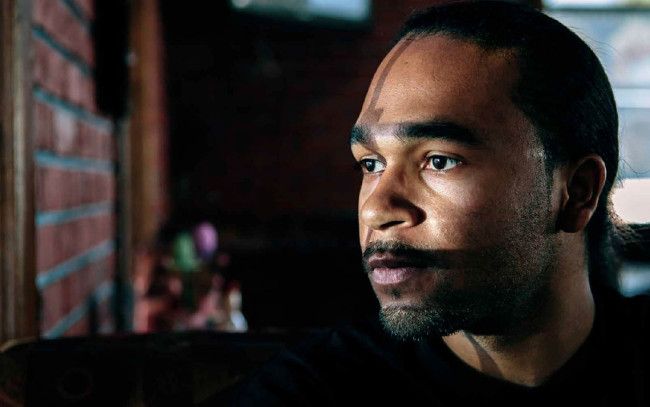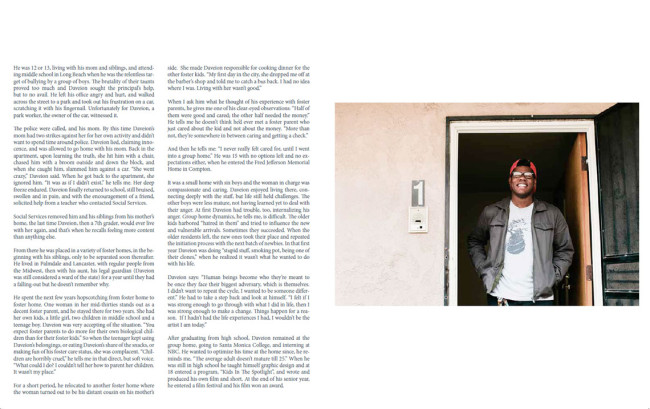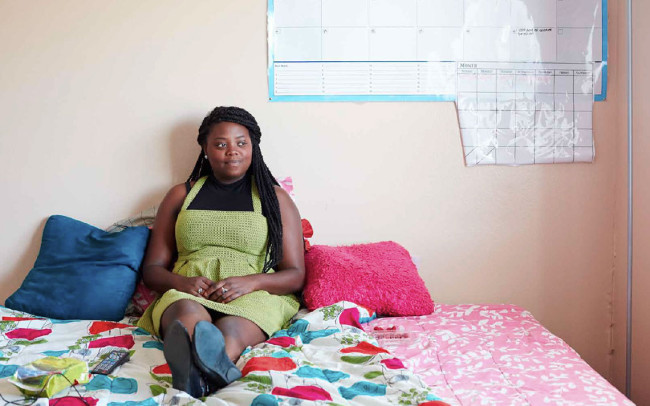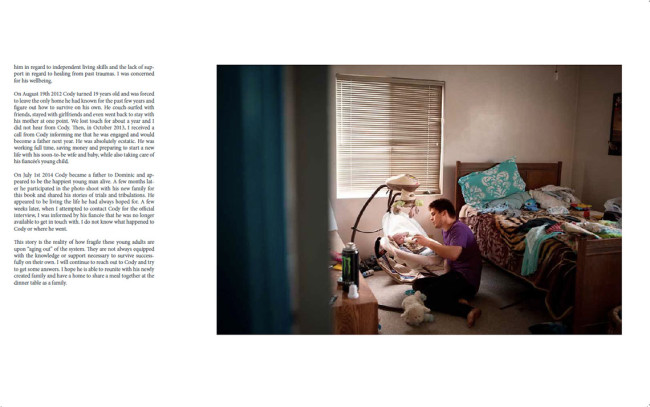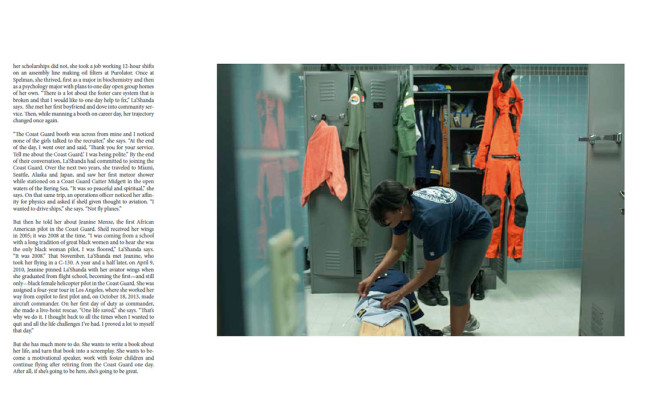A group of LA based photographers and journalists joined together to create a project that would raise awareness and support for the young men and women of Los Angeles aging out of the foster care system.
This collaboration resulted in a book and exhibition called “Aging Out.” I had the pleasure of chatting with the photographers about the book and their collective.
Aaron Fallon
Heidi: What drew you to this project?
Aaron Fallon: Around 2007 or 2008, I had seen a photo project with an accompanying story about young adults who had or were about to age out of the foster care system. I cannot recall the details, but the idea itself impacted me in the sense that I tried to imagine myself at 19, 20, or 21 years old having to face the world on my own without support of family, without someone to turn to or somewhere to go. And it seemed so overwhelming and scary. We all need support and a little help sometimes and to be at that stage in life without guidance or support — would, at the very least, be extraordinarily difficult. I wanted to start my own version of the project in Los Angeles. It was a way to use photography outside of my normal channels in a manner that might help others. Although I had done some other pro bono projects through the Taproot Foundation previously, this would be a project that truly resonated with me and I could have a lot more involvement and oversight of the entire process.
The idea stayed with me, but it didn’t come to fruition until several years later after the subject came up during a meeting with Maggie Soladay, (former photo editor of American Lawyer Magazine and Corporate Counsel Magazine), she had overseen a New York City version of a similar project and advised me about how to get things going. She suggested finding an editor/producer/creative director to partner with. Around the same time Coral Von Zumwalt had just put together a monthly meeting of sorts with several photographers in what would become the Image Hoarders. I reached out to Jacqueline Lee to take on the Editor/Producer/Creative Director role and pitched the idea to the Image Hoarders.
Joan Allen: Our earliest group conversations discussed the importance of having ongoing personal projects. Each of us would discuss the project we were currently working on or a new one we wanted to start and we would encourage one another to make progress on them, those of us who actually had time to get theirs started would share their accomplishments during meetings and would ask for feedback. When Aaron proposed this project to the group, it was during this time and we unanimously jumped at the opportunity to work on a creative group personal project, especially one that would raise awareness for such an important cause. The only creative conversations we had involved creating “a day in the life of” each subject. I think all of our photography and visions mixed very well together for a photo-journalistic, photo essay, reportage feel.
Matt Harbicht: I liked that we would be bringing attention to a subject that typically went unnoticed. We all had heard about this, but had never seen what life was like for people who have had this kind of childhood.
Matt Hoover
Matt Hoover: My passion is documentary photography, telling stories and meeting new people. One of the reasons I got into photography was to make a difference in my community or even the world if possible. This was an opportunity to tell a story of one persons life that might help others and bring awareness on what’s going on here in our own country.
Megan Miller: Aaron brought the idea and some information to our group. Once he showed us the sheer number of children aging out here in LA each year, and that LA County had the most children in the system of any county in the country, I think we all realized that something was happening in our own community that we didn’t know enough about. I wanted to learn more and then try and share that knowledge and awareness with others.
Yuri Hasegawa
Yuri Hasegawa: When this project came up, I was grieving heavily from the loss of my husband. My loss changed my entire life. My loss also changed me as a person, my perspective about life itself and affected me in both good and bad ways. One of the good changes after my loss is that I developed a desire to use my photography skills to help create something more meaningful in life, yet I had no clue about any specific idea or plan. Also, I was still too weak to feel “passion” to do anything more than keep living day by day. In a way, it was the most difficult time to think about a personal project on my own, even though I knew how much a new project would help me, after hearing about this, I immediately thought that this would be a great opportunity to be a part of a creative project and thought the timing was all happening for a reason. I liked the idea of having one project to work on with such an amazing collective of photographers (eventually to become the Image Hoarders) as a group collaboration.
Heidi: How did you find the subjects? Tell me about how you engaged with them and got them to open up?
Aaron: Joan Allen introduced us to the Alliance for Children’s Rights here in Los Angeles. The Alliance reached out to many of the Foster Youth they work with and put us in contact with those that were interested in being a part of it. Jacquie and I sorted through the potential subjects and tried to make sure we would be covering a broad spectrum of subjects and stories.
For both of my shoots, I met the subjects at their apartment and made sure we both allotted enough time to pretty much spend the day (afternoon) together. To me, this approach was best, as I could meet them in their own environment and without any particular time or location restrictions. We would sit and chat for a while. They’d tell me their story. I’d tell them about myself and the project. And then eventually we’d get around to creating some photos.
My first shoot was just Ernesto and myself. And the longer we chatted and then shot together, the more I learned about him. We went to lunch as well, and I shot some stuff with him in his neighborhood and at his favorite local restaurant.
My second shoot with Chardea, was in tandem with the writer. I let the writer do her thing first and I sat and listened. And after I chatted with Chardea. And took a similar approach as my first shoot. And we went to lunch as well.
Coral Von Zumwalt
Coral: Most of the subjects were brought to us through the Alliance for Children’s Rights which is an organization that serves as an advocate for foster kids and at-risk youth. However, one of my subjects, Cody, and I were brought together via a personal connection. My cousin worked with him years earlier as a childcare counselor at his group home. She knew his story was powerful and was impressed with how he had taken control over his life at the time.
With my subject, LaKendrea, I had the luxury of time which helps immensely when you are trying to connect with a subject. Over the course of three different days together, she became comfortable enough with my presence that I could just tag along and blend into the background as she lived her life. She allowed me to document her while she went about every day tasks like caring for her son, giving rides to her friends, visiting with her family, and potentially life-changing events like searching for an apartment and trying to convince a landlord to rent to her.
I also strive to have an empathetic ear, and I hope that comes across when I am with my subject. Being a good listener goes a long way toward helping anyone open up, and it holds true for subjects as well.
Lastly, it always helps to establish common ground between oneself and one’s subjects. Both of my subjects, for instance, are parents of young children. As a parent of young kids myself, we could share the universal joys and challenges that come with parenthood. There was also a period of time in my childhood when my mother was having troubles and a social worker had to intervene. I didn’t experience even one iota of what LaKendra or Cody went through, but there was a touchstone there I could go back to and it was easy to put myself in their shoes and understand them.
Joan: I was mentioning our book project to a dear friend of mine and at the time I had no idea she was independently highly involved and passionate about this cause on her own. She had a relationship with a non-profit organization who helps these young adults learn life and job skills to increase their chances of survival. She introduced me to a wonderful subject who ended up being one of the people I photographed and also to Alliance for Children’s Rights. We had a meeting with them and to my knowledge, most or all of the other subjects were introduced to us through the Alliance. My friend really helped us get the project off the ground in the beginning and I am very thankful to her for that.
Matt: Locking down people who came from troubled pasts was difficult. Sometimes people would fall out of contact because they had switched homes or had other trouble. Some just fell out of contact completely.
Matt Hoover: Most of the time meeting someone new to photograph I like to sit down and introduce myself. Tell them where I’m from and what I’m doing. I like to listen to my subjects and here what they are doing, what’s going on in their life, etc… You can’t rush it, you have to sit down and take your time, get to know the person your going to photograph. No one is going to open up and feel comfortable around someone new who shoves a camera in their face. You have to gain trust first then let moments unfold in front of you.
I also like to use humor when meeting someone new, whether it be for a project or just out and about in the world.
Megan Miller
Megan: To get to know who I was photographing I just made sure to have a real, full conversation with them before I ever even took the camera out. The great thing about it being a personal project, is that you can spend as much time as you need.
Heidi: When you shoot something this emotionally complex, how to you prepare for the shoot if at all?
Coral: Shooting stories like these are really refreshing actually because I feel I have to prepare less. Instead of agonizing, like I often do for my editorial and commercial shoots, over what type of equipment to use, what assistant and/or digital tech is available, is there budget for a producer, will the subject give me more than 15 minutes, etc., I instead just get to concentrate on the subject. It is just me and my camera and the subject. And because neither of the stories had been written for Cody or LaKendra before I shot them, I went in with minimal information and got to hear their story firsthand.
Joan Allen
Joan: I don’t personally feel that I had to prepare any differently than I do with any other shoot. I just wanted to get to know these wonderful and strong peole and hear their stories. I asked to just hang out with them during normal daily routines, making dinner, etc. I didn’t just show up and grab my camera and go for it. I wasn’t in a hurry. I would meet and talk to my subjects and ask questions and just help them not think about it being a photo shoot until I sensed they were relaxed and I was just some regular friend hanging out in their living room. Then, when I was sure their guards were down, I would just keep talking but start taking photos as well. I did photography Lt. LaShanda Holmes for two separate days at the National Coast Guard at LAX Airport. Those shoot dates required being much more scheduled with our time, as, permission was needed for LaShanda to be part of the project, for me to be able to photograph at the Coast Guard, for me to be able to photograph the helicopters and her in uniform and for her specifically scheduled slots of time that needed approval. Those days did not allow for the flexibility of just “hanging out” beforehand.
* Joan Allen also shot the cover image.
Matt Harbicht
Matt: You think about what’s important to illustrate this person’s story. If you are in their homes, the first thing you notice is how bare they are. Most of us have acquired an enormous amount of “stuff” throughout lives. We all knew this going into our shoots so things like the emptiness of their environment would be something to focus on. For many people the idea of their own place or home was integral to their story. In my case I didn’t know what the situation was going to be, so I just ran with it.
Matt Hoover: I really try to think about what this person has gone through. What obstacles might have come into their life. What would I have done or felt if these things happened to me.
You can’t really prep for certain things because you have no idea what this person has gone through. You just need to listen and go with the flow.
The portraits are a deep reveal into ove coming so much in their lives, how hard was the edit and what were you looking for in the final select?
Aaron: In making final submissions I wanted to show a broad range about the person I was photographing. Yes, both of the people I photographed had pasts that would be considered emotionally heavy, but that doesn’t define either those people. So, if I have an image that may be reflective or poignant and could be viewed to reference their past — great, but I also looked for lighter moments, or moments that show who that person is now. And with both of my subjects we had fun moments during the shoot, so I wanted to make sure to include those as well.
Coral: I found it hard to edit because as I became closer to my subjects, LaKendra in particular because we spent more time together, I found I was editing out images that told a fuller story because I was acutely aware of her feelings and did not want to show any images that didn’t paint her in the best light. As with many jobs, however, I went back a second and third time – each time trying to put on fresh eyes – and put forward, what I hope, is the most honest story possible.
Matt: I think I was looking for something that showed their strengths and a look at the struggle they had gone through. We visited her old school as school was always the driving force in Jasmine’s life. She showed me the Taco Bell she waited at for people from the Hollywood Youth Shelter to come get her. Seeing these places that had little or no meaning to me were the driving force behind what changed her life. It was powerful to walk those steps with her.
Megan: As far as what I was looking for to send to Jacqui, I was just trying to show the entire range of the person I had gotten to know. The positive moments, the struggles. That’s difficult to do in just a few images, so I was just hoping for that to come through.
Yuri: I do feel that I had more of a tendency to be subjective easily on this edit. My biggest problem was, shamefully, the lack of variation. There were a few technical issues on the shoot day, which limited our option to get more variety in terms of locations and different situations. I attempted to book a second shoot date, but, my efforts failed. That part was a huge challenge for me, wanting something more and not being able to create it.
Coral, tell us about why you created ImageHoarders.
Early in my career, I had the good fortune of working as Art Streiber’s first assistant. Over those five or so years, I truly felt part of a tight-knit photographic community. Logistically, Art’s shoots were often quite big – they felt more like a small film shoot rather than a still shoot – so I was working along side many assistants, set designers, stylists, creatives, etc. I felt like part of a team and there was always a tremendous amount creative collaboration. And more than any other photographer I’ve known, Art truly enjoys fostering photographic friendships and mentoring young photographers – he is very generous with his time and experience.
After shooting on my own for close to 10 years, I found myself feeling isolated and missing the sense of community I felt while working with Art. My shoots are typically pretty intimate… oftentimes I am shooting with just one assistant by my side, and then I spend an ungodly amount of time alone while I edit (and edit again – I am a slooooow editor). I missed the group dynamic and was craving the conversation of photography. But I didn’t want to take part in something formal and regimented – I wanted something intimate and casual and inspiring. One night, over beers and archiving woes in my garage, I was talking with a couple friends about this quest to find my own little photo version of the Algonquin Round Table and I realized other people were craving the same thing. So that was the nexus of ImageHoarders. I invited a handful of photographers whose work I respect into my living room. Some are friends that I assisted alongside with years ago and are now established shooters. Others are former assistants of mine who I missed working and hanging out with because they are now busy shooting on their own or making that transition into shooting full time. There is a range of age and experience within the group which benefits us all, I think. And it is a safe place to share information, bounce ideas off each other and show work in progress. Now roughly two years later, we continue to inspire each other to do better work and we enjoy each other’s company while doing it.

